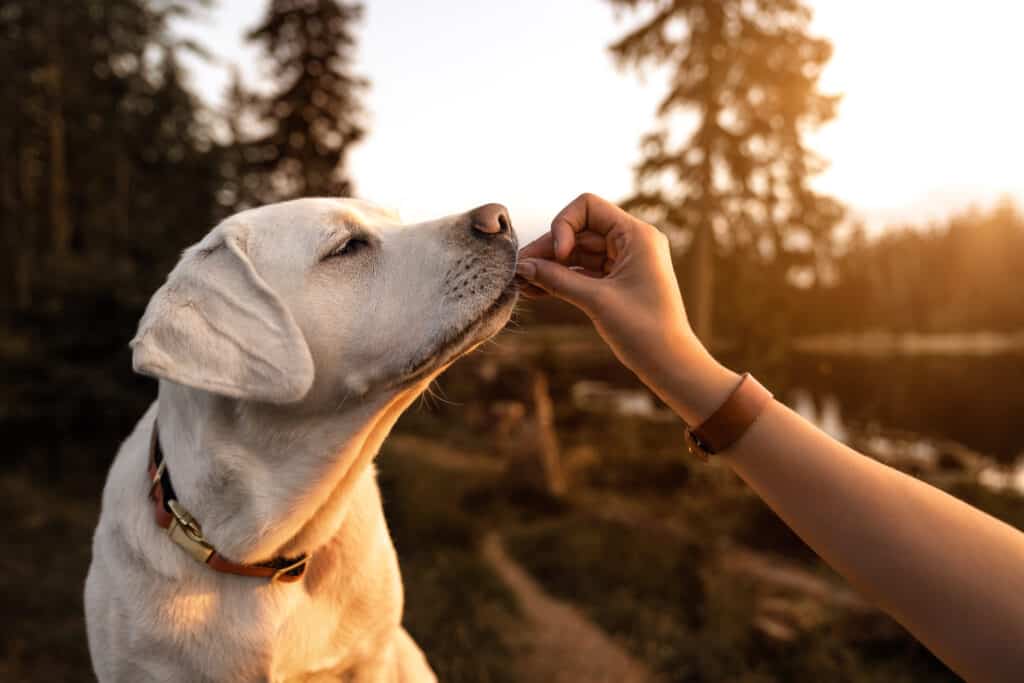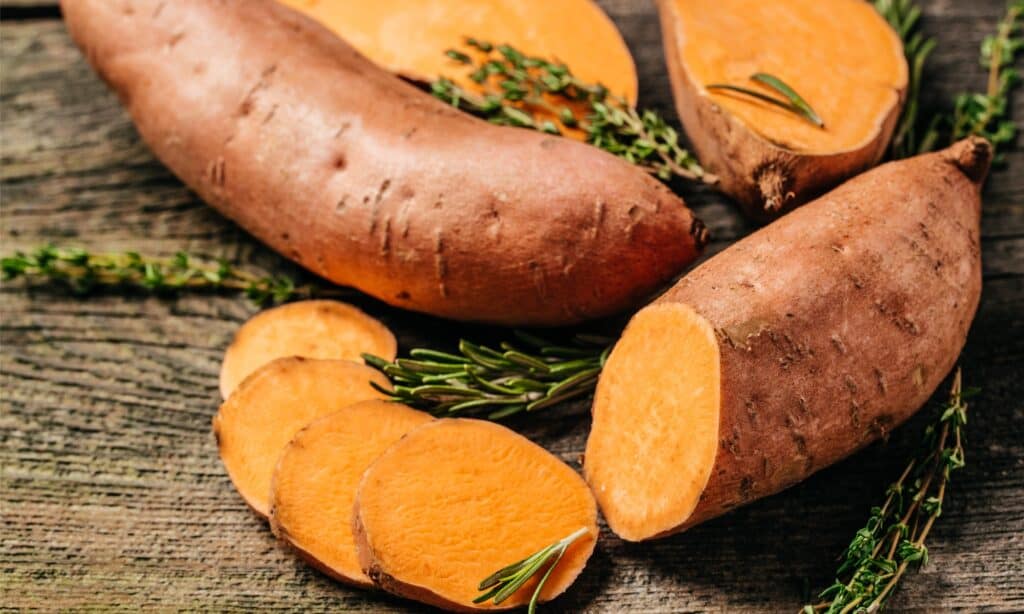Yams–and sweet potatoes, although they’re not the same thing–are great for dogs. Because sweet potatoes and yams are so similar and so commonly confused for one another, this article covers both.
Your dog can eat cooked yams, and they come with health benefits like reduced inflammation, a regulated digestive system, and a boosted immune system amongst others. Raw yams are unsafe for dogs because they contain tannins, which are toxic.
In this article, we’ll discuss the health benefits of yams, why dogs shouldn’t eat raw yams, their differences to sweet potatoes, and more.
Dogs Can Eat Cooked Yams

Cooked yams are perfectly safe for your dog to eat and offer many health benefits, including reduced inflammation, decreased risk of developing certain diseases, and increased energy levels.
©Abimbola Olayiwola/Shutterstock.com
Cooked yams are perfectly safe for your dog to eat and offer many health benefits, including reduced inflammation, decreased risk of developing certain diseases, and increased energy levels.
It’s important that yams are served plain or with other dog-safe ingredients, such as if they’re baked into dog treats or an ingredient in your dog’s food.
You can cook yams for your dog yourself, but please don’t add sugar, spices, salt, butters, or oils. These are unneeded and may hurt your dog, particularly if served in large amounts or if you use toxic spices, like garlic or onion powders.
Feel free to leave the skin on when serving it to your dog, as it’s also very nutritious!
Avoid yams in syrup, candied yams, and canned yams as they contain too much sugar. Canned yams may also contain preservatives that are unhealthy for your pooch.
Benefits of Cooked Yams for Dogs
True yams and sweet potatoes both have many health benefits–and nearly the same ones, at that! Below is a list of benefits you’ll see, no matter which food you feed your dog.
Reduced Risk of Heart Disease and Cancer
Yams contain beta-carotene and vitamin A, which can reduce the chance of your dog developing heart disease and certain cancers.
Sweet potatoes have triple the amount of beta-carotene as true yams, so if you’re looking for that added vitamin A, they might be the best choice for your pup.
Reduced Inflammation
Yams also contain Diosgenin, an anti-inflammatory. Inflammation contributes to many health conditions, including arthritis, joint pain, heart disease, diabetes, cancer, and dementia.
Feeding your dog foods like yams that reduce inflammation can decrease their risk of developing these diseases or help ease symptoms like arthritis pain.
A Regulated Digestive System
The fiber in yams can help regulate your dog’s digestive system. Fiber-inclusive foods like yams are often fed or mixed into a dog’s food when they have tummy problems like diarrhea or constipation.
Of course, you always want to see the vet if your dog is showing symptoms of illness like an upset stomach. But, adding some fiber to their diet might help in the meantime while you wait for an appointment.
You can also ask your vet about adding yams to your dog’s diet while they’re having tummy issues, especially if they happen frequently and you’re already treating the underlying cause.
Boost to the Immune System
Vitamin C in yams boosts your dog’s immune system and can help fight off illness.
Of course, yams aren’t an antibiotic or a surefire way to prevent your dog from getting sick, but a healthy diet can go a long way toward protecting your dog!
Sweet potatoes contain slightly more vitamin C than true yams.
High Amounts of Calcium
Yams also contain high amounts of calcium, which promotes healthy bones, teeth, heart, nervous system, and muscles. Calcium is very important in a dog’s diet–they actually need much more calcium than humans do on the daily.
Growing puppies need even more calcium (three times as much!) than adult dogs to support their muscle and bone growth.
Of course, all the calcium your dog needs should be in their dog food already–but a little extra won’t harm them!
Increased Energy Levels
Potassium helps keep your dog’s energy levels at a healthy level. If you have a super active dog breed, don’t worry–it’s not like sugar where it’ll hype them up considerably.
But, potassium does give a dog’s body the energy it needs to live day to day, whether they’re running after balls in the backyard, playing tug-of-war, and going on walks.
Raw Yams are Toxic to Dogs

If your dog eats raw yams, it’s important to bring them to the vet right away.
©iStock.com/igorr1
Raw yams contain tannins, and these compounds are toxic to dogs. Tannins are removed in the cooking process, making the yams safe to eat.
If your dog eats raw yams, it’s important to bring them to the vet right away. If your primary veterinarian is not open or available, please call your closest emergency clinic for help.
Symptoms of tannin poisoning in dogs include:
- Vomiting
- Diarrhea
- Stomach pain
- Dehydration
- Shock
- Kidney failure
- Liver damage
Please remember that you cannot see the effects of organ damage or failure until it’s severe. By the time you notice side effects of poisoning, it might be too late to save your dog’s life–and even if not, the organ damage cannot be undone.
This is why it’s important to seek treatment immediately, rather than waiting to see how your dog fares over time. Your vet can run bloodwork and other diagnostics to evaluate your dog’s kidneys and liver, and help them right away if needed to prevent further damage.
In extreme cases, and especially without treatment, dogs can die from tannin toxicity.
How to Feed Your Dog Yams

The best way to feed your dog yams is to occasionally bake them into homemade dog treats or cook them plain and cut them into small bites.
©manushot/Shutterstock.com
Dogs can be fed yams plain, in dog treats, or mixed into their kibble to make it more palatable. Before feeding your dog yams, particularly on a consistent basis, it’s important to speak to your veterinarian.
Most dogs are fine eating small amounts of yams as a treat, but dogs with certain chronic illnesses in particular may suffer adverse effects like high blood sugar.
The best way to feed your dog yams is to occasionally bake them into homemade dog treats or cook them plain and cut them into small bites. Whole yams can be difficult for a dog to swallow and digest–there is a risk of them choking or a large piece of yam causing a bowel obstruction.
I don’t recommend feeding your dog an entire yam, especially regularly. It’s better to feed them a couple of small bites.
Of course, the amount of yams your dog can eat will depend on their size as well.
Remember to always feed new foods in small amounts and watch for any adverse effects, such as upset stomach. Some dogs are more sensitive than others, so this is another thing to keep in mind when adding new foods to your dog’s diet.
Are Sweet Potatoes or Yams Better for Dogs?

Sweet potatoes are lower in calories and higher in both vitamin C and beta-carotene (which provides vitamin A).
©iStock.com/Koval Nadiya
Some people use the words sweet potato and yam interchangeably, but they’re actually different foods.
Sweet potatoes are redder in color and are typically orange on the inside. Yams have a rougher skin, and are very pale on the inside. Sweet potatoes, as you guessed, are also sweeter in flavor.
The reason so many of us call sweet potatoes yams is that yams originate from Africa, and aren’t widely sold in the United States. Often, sweet potatoes are even labeled as yams in grocery stores.
Sweet potatoes are lower in calories and higher in both vitamin C and beta-carotene (which provides vitamin A). Therefore, they’re overall the healthier choice–but both foods are good for your dog and provide very similar health benefits.
Both should also be cooked to rid them of tannins, which are toxic to dogs. If your dog gets into raw yams or sweet potatoes, see a veterinarian right away.
No matter which food you’re feeding, we hope this article has helped you make the decision for or against adding yams to your dog’s diet. Remember to always make dietary decisions for your dog alongside a trusted veterinarian and feed all treats in moderation!
Up Next
- Feeding Your Dog Pumpkin: Risks, Dosage, and More
- The Benefits and Dangers of Your Dog Eating Squash
- Can Dogs Eat Potatoes? (The Answer Varies)
The photo featured at the top of this post is © jiangdi/Shutterstock.com
Ready to discover the top 10 cutest dog breeds in the entire world?
How about the fastest dogs, the largest dogs and those that are -- quite frankly -- just the kindest dogs on the planet? Each day, AZ Animals sends out lists just like this to our thousands of email subscribers. And the best part? It's FREE. Join today by entering your email below.
Thank you for reading! Have some feedback for us? Contact the AZ Animals editorial team.






